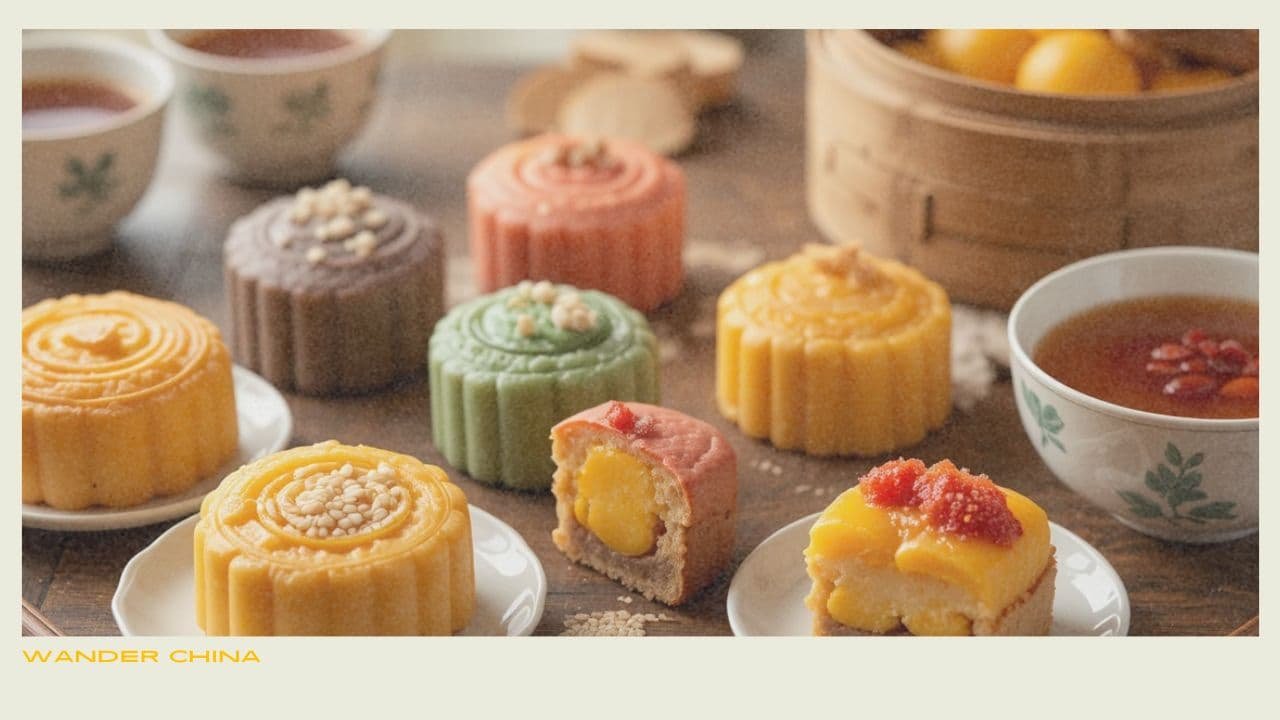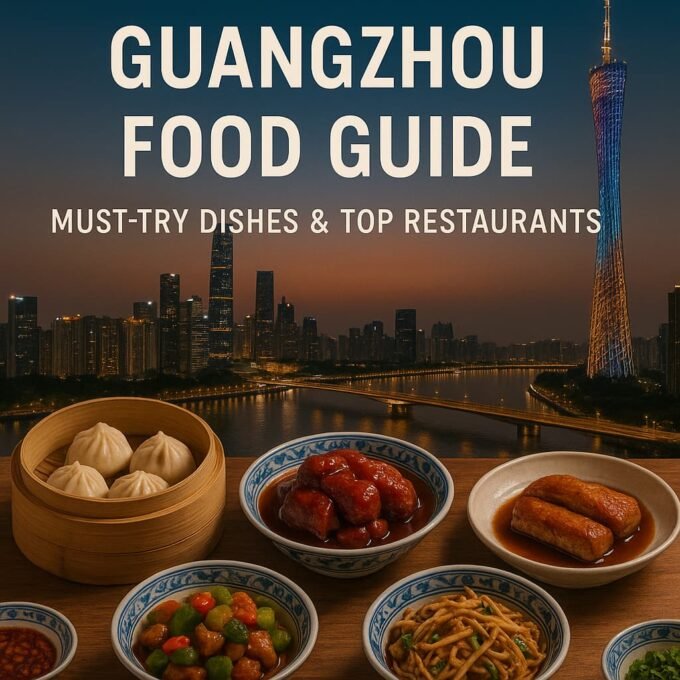Easy Chinese Desserts To Satisfy Your Sweet Tooth
Make 5 simple Chinese desserts: mooncakes, tangyuan, red bean soup, egg tarts, and yuanxiao.

This article aims to introduce a selection of easy Chinese desserts that are not only delicious but also simple to prepare, even for those with limited cooking experience. Whether you’re a curious traveler seeking to indulge in local flavors or an expat looking to recreate a taste of home, these desserts will provide a delightful introduction to the sweet side of Chinese cuisine.
By focusing on accessible recipes with readily available ingredients and straightforward preparation methods, we hope to demystify the art of Chinese dessert-making and encourage you to explore this fascinating culinary realm. From no-bake treats to vegan and vegetarian options, we’ve curated a range of desserts that cater to various dietary preferences and skill levels.
So, let’s embark on a journey through the world of easy Chinese desserts, where you’ll discover not only delectable flavors but also gain insights into the cultural significance and regional variations that make these sweet treats truly unique.
Traditional Chinese Dessert Ingredients
Chinese desserts often feature a unique blend of ingredients that may be unfamiliar to those outside of the culture. However, these ingredients are not only delicious but also hold cultural significance and health benefits. Here are some common ingredients found in traditional Chinese desserts:
Red Bean Paste: Made from azuki beans, this paste has a sweet, nutty flavor and is a staple in many Chinese desserts, such as red bean soup, red bean buns, and red bean cakes. It’s not only delicious but also rich in fiber, protein, and antioxidants.
Glutinous Rice: Also known as sticky rice, this short-grain rice variety is used in desserts like tangyuan (sweet rice balls), zongzi (sticky rice dumplings), and nian gao (sticky rice cake). Glutinous rice has a chewy, stretchy texture and is gluten-free.
Coconut Milk: Extracted from the flesh of mature coconuts, coconut milk adds a rich, creamy texture and subtle sweetness to desserts like coconut pudding, coconut jelly, and coconut tapioca pearls. It’s also a good source of healthy fats and nutrients.
Black Sesame Seeds: These tiny, nutty-flavored seeds are often used in desserts like sesame balls, sesame soup, and sesame paste. They’re rich in protein, fiber, and minerals like calcium and iron.
Taro: This starchy root vegetable has a distinct purple color and a slightly sweet, nutty flavor. It’s used in desserts like taro pudding, taro balls, and taro ice cream. Taro is also a good source of fiber and vitamins.
Lotus Seeds: These edible seeds from the lotus plant have a slightly sweet and nutty taste. They’re often used in desserts like lotus seed soup, lotus seed paste, and lotus seed buns. Lotus seeds are rich in protein, vitamins, and minerals.
Jujube: Also known as Chinese dates, these small, reddish-brown fruits have a sweet, slightly tart flavor and are often used in desserts like jujube soup, jujube tea, and candied jujubes. Jujubes are a good source of vitamins and antioxidants.
These ingredients not only add unique flavors and textures to Chinese desserts but also offer various health benefits, making them a delightful and nutritious addition to any dessert lover’s repertoire.

Easy Chinese Dessert Recipes for Beginners
If you’re new to Chinese desserts, these simple recipes are a great place to start. They use familiar ingredients and straightforward techniques, making them approachable for beginners.
Egg Tarts
Egg tarts are a beloved Chinese bakery treat with a smooth egg custard filling in a buttery tart shell. Here’s an easy recipe:
Ingredients:
- 1 package frozen tart shells (or make your own pastry dough)
- 4 eggs
- 1/2 cup white sugar
- 1/4 tsp vanilla extract
- 1 cup hot water
- 1/2 cup evaporated milk
Instructions:
- Pre-bake the tart shells according to package instructions until lightly golden.
- In a bowl, whisk together the eggs, sugar, and vanilla until smooth.
- Whisk in the hot water and evaporated milk until fully incorporated.
- Pour the egg mixture into the pre-baked tart shells, filling them about 3/4 full.
- Bake at 325°F for 15-20 minutes until the custard is set but still jiggles slightly.
- Allow to cool completely before serving.
Mango Pudding
Silky and refreshing, mango pudding is a popular Cantonese dessert. This version uses fresh mangoes for maximum flavor.
Ingredients:
- 1 ripe mango, pureed
- 1/2 cup white sugar
- 1 cup water
- 1 packet unflavored gelatin
- 1/4 cup cold water
Instructions:
- In a saucepan, combine the mango puree, sugar, and 1 cup of water. Heat until steaming but not boiling.
- In a small bowl, sprinkle the gelatin over the 1/4 cup cold water and let bloom for 5 minutes.
- Add the bloomed gelatin to the hot mango mixture and stir until fully dissolved.
- Pour into serving dishes and refrigerate for at least 4 hours until set.
Red Bean Soup
This comforting dessert soup features soft red beans simmered in a sweet broth. It’s a beloved Cantonese classic.
Ingredients:
- 1 cup dried red beans (adzuki), soaked overnight
- 5 cups water
- 1/2 cup rock sugar (or white sugar)
- 1 inch ginger, sliced
- Tapioca pearls (optional)
Instructions:
- Drain and rinse the soaked red beans. Add to a pot with 5 cups fresh water.
- Add the rock sugar and ginger slices. Bring to a boil.
- Reduce heat and simmer for 1-2 hours, until beans are very soft and soup is thickened.
- Add tapioca pearls in the last 15 minutes if using.
- Remove ginger slices before serving warm or chilled.
These iconic desserts make a great introduction to Chinese sweets. They’re easy for beginners but still capture the authentic flavors of traditional Chinese desserts.
No-Bake Chinese Desserts
For those without access to an oven or looking for a quick and easy dessert option, no-bake Chinese desserts are a perfect choice. These delightful treats require minimal effort and can be whipped up in no time, making them ideal for busy schedules or when you’re craving something sweet without the hassle.
One of the most popular no-bake Chinese desserts is almond tofu, also known as almond agar or almond jelly. This delicate and refreshing dessert is made by combining almond milk, agar-agar (a plant-based gelatin substitute), and sugar. The mixture is then chilled until it sets into a soft, jelly-like consistency. Almond tofu can be served plain or with a variety of toppings, such as fresh fruit, syrup, or coconut milk.
Another no-bake delight is fruit jellies, which are made by combining fruit purees or juices with gelatin or agar-agar. These jellies can be molded into various shapes and flavored with ingredients like lychee, mango, or coconut. They make for a light and refreshing treat, perfect for hot summer days or as a palate cleanser after a heavy meal.
Candied fruits, also known as preserved or crystallized fruits, are another no-bake option that showcases the vibrant flavors of Chinese cuisine. Fruits like kumquats, ginger, and citrus peels are cooked in sugar syrup until they become translucent and coated in a sweet, candy-like glaze. These candied fruits can be enjoyed on their own or used as a garnish for other desserts.
For those with a sweet tooth, no-bake Chinese desserts offer a delightful and hassle-free way to indulge in the rich flavors of traditional Chinese cuisine. Whether you’re looking for a refreshing treat or a sweet pick-me-up, these no-bake options are sure to satisfy your cravings.
Vegan and Vegetarian Chinese Desserts
For those following a vegan or vegetarian lifestyle, there are plenty of delicious Chinese dessert options to explore. Many traditional Chinese sweets are naturally plant-based, making them suitable for those with dietary restrictions.
One popular vegan dessert is coconut pudding, also known as “Nai Wong Bao.” This creamy and refreshing treat is made by simmering coconut milk with sugar and thickening it with cornstarch or tapioca flour. It’s often served chilled and can be garnished with fresh fruit or toasted coconut flakes.
Another vegan-friendly option is the iconic sweet soup desserts, such as red bean soup, black sesame soup, or taro soup. These comforting and nourishing desserts feature a variety of plant-based ingredients like beans, nuts, and root vegetables, simmered in a sweet broth and sometimes thickened with rice flour or tapioca.
For those with a sweet tooth, vegan variations of Chinese pastries and baked goods are also available. Steamed buns filled with sweetened bean paste or coconut fillings, as well as vegan mooncakes made with plant-based ingredients like lotus seed paste and coconut oil, are popular choices.
Vegetarians can also enjoy many of these desserts, as well as egg-based sweets like the classic egg tarts or the fluffy and sweet sponge cakes. Additionally, many Buddhist temples and vegetarian restaurants in China offer a wide selection of vegetarian-friendly desserts, often incorporating ingredients like tofu, nuts, and fruits.
Regional Chinese Dessert Specialties
China is a vast country with diverse regional cuisines, and this diversity extends to its dessert offerings as well. Each province and region has its own unique specialties, reflecting local ingredients, flavors, and culinary traditions. Exploring these regional variations can be a delightful journey for those seeking to immerse themselves in the rich tapestry of Chinese dessert culture.
In the southern region of Guangdong, Cantonese desserts are renowned for their delicate flavors and intricate presentations. One iconic treat is the humble yet beloved egg tart, with its flaky pastry shell and silky egg custard filling. Another Cantonese specialty is the mango pudding, a velvety dessert made with fresh mangoes and often topped with a vibrant mango purée.
Moving northward to Sichuan, the desserts take on a bolder, more robust character, reflecting the region’s love for spicy and numbing flavors. The tanghulu, or candied hawthorn skewers, are a popular street snack, featuring tart hawthorn fruits coated in a sticky, sugary glaze. Sichuan also boasts unique ice cream flavors like rose and green tea, showcasing the region’s affinity for floral and herbal notes.
In the coastal province of Fujian, desserts often feature tropical fruits and a touch of sweetness. The pineapple tart, with its buttery crust and tangy pineapple filling, is a beloved treat. Another Fujian specialty is the aiyu jelly, a refreshing dessert made from the gel-like seeds of a local plant, often served with syrup or coconut milk.
The northern regions of China offer their own unique dessert traditions. In Beijing, the capital city, you’ll find the iconic jian dui, or fried sesame balls, crispy on the outside and filled with a sweet red bean paste. Nearby Tianjin is famous for its zhuzha tang, a warm, comforting soup made with candied fruits and nuts, often enjoyed during the winter months.
These are just a few examples of the diverse and delicious dessert specialties found across China’s regions. Exploring these local treats can be a delightful way to immerse yourself in the country’s rich culinary heritage and gain a deeper appreciation for the flavors and traditions that make Chinese desserts so unique and beloved.
Dessert Etiquette and Customs in China
In Chinese culture, desserts are not just sweet treats but also carry symbolic meanings and play a role in various traditions and customs. Understanding the etiquette and customs surrounding desserts can enhance your appreciation of Chinese cuisine and culture.
One common practice is to serve desserts during celebratory occasions, such as Chinese New Year, weddings, and birthdays. Certain desserts are believed to bring good luck and prosperity. For instance, sticky rice balls (tang yuan) are served during the Lantern Festival, symbolizing unity and togetherness.
When dining with Chinese hosts, it is polite to try the desserts offered, even if you are already full from the main course. Refusing dessert may be seen as impolite or disrespectful to the host’s efforts. However, it is also considered impolite to finish every last bite, as leaving a small portion behind signifies that you have had enough.
In Chinese culture, sharing desserts is a way to show appreciation and strengthen relationships. It is common to see families or friends sharing a dessert or splitting a dessert among the group. This practice promotes bonding and harmony.
Certain desserts are also associated with specific occasions or festivals. For example, mooncakes are traditionally consumed during the Mid-Autumn Festival, while nian gao (sticky rice cake) is a must-have during Chinese New Year celebrations.
When presenting desserts, Chinese culture emphasizes presentation and aesthetics. Desserts are often intricately crafted and beautifully arranged, reflecting the artistry and attention to detail in Chinese cuisine.
It is also worth noting that in some regions of China, desserts may not be as prevalent or may be less elaborate compared to other regions. For instance, in certain parts of northern China, desserts are often simpler and less sweet, reflecting the local cuisine and preferences.
Overall, desserts in Chinese culture are not just sweet indulgences but also hold cultural significance and are deeply intertwined with traditions, festivals, and social customs.
Where to Find Chinese Desserts in China
One of the best ways to experience authentic Chinese desserts is to seek them out from local vendors and establishments during your travels in China. Here are some recommendations on where to find delicious Chinese desserts:
Street Food Stalls and Night Markets: Street food is a quintessential part of Chinese culinary culture, and many night markets offer a wide array of traditional desserts. From tanghulu (candied fruit on a skewer) to jian bing (stuffed crepes), you’ll find an abundance of sweet treats to sample.
Traditional Bakeries: Look for old-school bakeries that have been around for generations. These establishments often specialize in regional desserts and use time-honored recipes passed down through the years. Try to find bakeries that display their wares in the storefront, allowing you to see the tempting array of options.
Dessert Shops and Cafés: In major cities like Beijing, Shanghai, and Guangzhou, you’ll find trendy dessert shops and cafés that put a modern spin on classic Chinese sweets. These spots are great for trying innovative creations and fusion desserts that blend traditional flavors with contemporary techniques.
Teahouses: Teahouses are a cultural institution in China, and many offer a selection of desserts to accompany their fine teas. Indulge in delicate sweets like egg tarts, sesame balls, or mochi while sipping on a fragrant brew.
Restaurants: While not the primary focus, many Chinese restaurants will have a dessert menu featuring regional specialties. After savoring a hearty meal, cap it off with a traditional dessert like tangyuan (glutinous rice balls) or lao po bing (wife cake).
Local Markets: Explore local markets and food halls, where you’ll often find vendors selling freshly made desserts. These can be great spots to discover lesser-known regional treats and sample sweets made with locally sourced ingredients.
Remember, don’t be afraid to ask locals for recommendations or follow the crowds to popular dessert spots. Immersing yourself in the sweet side of Chinese cuisine is a delightful way to experience the country’s rich culinary heritage.
Healthier Alternatives to Traditional Desserts
Many classic Chinese desserts are known for their heavy use of sugar, oils, and other rich ingredients. However, with a few simple tweaks, you can enjoy the delightful flavors of these treats while making them more nutritious and guilt-free. Here are some healthier alternatives to traditional Chinese desserts:
Swap Refined Sugar for Natural Sweeteners: Instead of using white sugar, try substituting it with natural sweeteners like honey, maple syrup, or monk fruit sweetener. These alternatives not only reduce the overall sugar content but also provide additional nutrients and a distinct flavor profile.
Use Whole Grains: Opt for whole grain flours like brown rice flour, buckwheat flour, or whole wheat flour when making desserts like steamed buns, dumplings, or pastries. Whole grains offer more fiber, vitamins, and minerals compared to their refined counterparts.
Incorporate Fruits: Chinese desserts often feature fruits like lychees, longans, and oranges. Increase the fruit content in your desserts to add natural sweetness, fiber, and a variety of vitamins and antioxidants.
Experiment with Alternative Milks: Instead of using full-fat dairy milk, try plant-based alternatives like almond milk, coconut milk, or oat milk. These options are lower in calories and saturated fat, making them a healthier choice for desserts like puddings, soups, or custards.
Reduce Oil and Butter: Traditional Chinese desserts can be heavy on oils and butter. Consider using cooking sprays, applesauce, or mashed bananas as substitutes to cut down on unnecessary fats while still maintaining moisture and texture.
Embrace Steaming and Baking: Steaming and baking are healthier cooking methods compared to deep-frying. Opt for steamed buns, cakes, or baked goods instead of fried desserts to reduce the overall calorie and fat content.
Incorporate Superfoods: Add a nutritional boost to your desserts by incorporating superfoods like chia seeds, flaxseeds, or matcha powder. These ingredients are packed with essential nutrients and can add unique flavors and textures to your treats.
Remember, moderation is key when indulging in any dessert, even the healthier alternatives. By making simple substitutions and embracing nutrient-dense ingredients, you can enjoy the delightful flavors of Chinese desserts while prioritizing your overall well-being.
Tips for Making Chinese Desserts at Home
While many Chinese desserts can seem intimidating to recreate at home, with the right ingredients, tools, and techniques, it’s entirely possible to enjoy delicious homemade versions. Here are some tips to help you get started:
Sourcing Ingredients: Many traditional Chinese dessert ingredients can be found at Asian grocery stores or in the international aisle of larger supermarkets. Look for items like glutinous rice flour, red bean paste, taro, coconut milk, and rock sugar. If you can’t find certain ingredients locally, consider ordering them online.
Essential Tools: Invest in a few key tools to make your dessert-making experience easier. A steamer basket is essential for steamed desserts like buns and cakes. A wok or small non-stick pan is handy for frying and caramelizing. Other useful tools include a bamboo steamer, small offset spatula, and a mortar and pestle for grinding spices.
Mastering Techniques: Many Chinese desserts rely on specific techniques like steaming, frying, and caramelizing. Practice these methods and don’t be afraid to experiment. Steaming is a gentle cooking method that preserves flavors and textures, while caramelizing adds depth and complexity to desserts like egg tarts.
Adjusting Sweetness: Traditional Chinese desserts are often less sweet than Western desserts. If you prefer a sweeter taste, add a little more sugar or honey to the recipe. However, be careful not to overdo it, as the balance of flavors is essential.
Presentation Matters: Chinese desserts are often as visually appealing as they are delicious. Take the time to plate your desserts beautifully, using traditional dishes or plates. Garnish with fresh fruit, nuts, or a dusting of powdered sugar for an extra touch of elegance.
Patience and Practice: Like any culinary endeavor, making Chinese desserts at home takes patience and practice. Don’t be discouraged if your first attempts aren’t perfect. Keep experimenting, adjusting recipes to your taste, and enjoying the process of learning a new culinary tradition.
With these tips in mind, you’ll be well on your way to creating authentic and delicious Chinese desserts in your own kitchen, impressing your friends and family with your newfound skills.
Conclusion
Exploring the world of easy Chinese desserts is a delightful journey that offers a taste of rich cultural traditions and flavors. From the simplicity of no-bake treats to the intricate artistry of regional specialties, these desserts showcase the diverse culinary landscape of China.
Whether you’re a traveler seeking authentic experiences, an expat longing for a taste of home, or simply a food enthusiast curious about new flavors, embracing the world of Chinese desserts is a rewarding endeavor. These sweet delights not only satisfy your cravings but also provide a glimpse into the customs, ingredients, and techniques that have been passed down through generations.
So, don’t hesitate to venture into the realm of easy Chinese desserts. Experiment with the recipes, savor the unique flavors, and appreciate the cultural significance behind each bite. Who knows, you might just discover a new favorite treat that becomes a cherished part of your culinary adventures.
Remember, the key to mastering these desserts lies in embracing the spirit of simplicity and authenticity. Take the time to source quality ingredients, follow traditional techniques, and most importantly, enjoy the process of creating and savoring these sweet delights.
Embark on this delectable journey, and let the flavors of easy Chinese desserts transport you to a world of culinary delight and cultural enrichment.
Recent Posts
- Top Guangzhou Watch Markets to Visit in 2025: The Ultimate Insider’s Guide
- My Guide to the Best Home Appliance Markets in Guangzhou
- Guangzhou Garment Wholesale Markets: My Local Guide
- Best Hotel in Guangzhou: A Comprehensive Guide for Foreign Travelers
- Guangzhou Food Guide: Must-Try Dishes & Top Restaurants (2025 Edition)
Recent Comments
Top Guangzhou Watch Markets to Visit in 2025: The Ultimate Insider’s Guide
I visited the top watch markets in Guangzhou to show you where...
My Guide to the Best Home Appliance Markets in Guangzhou
Explore top offline home appliance markets in Guangzhou with local tips, Chinese...
Best Hotel in Guangzhou: A Comprehensive Guide for Foreign Travelers
Find the best hotels in Guangzhou—from luxury icons to local favorites. Updated...
Guangzhou Food Guide: Must-Try Dishes & Top Restaurants (2025 Edition)
I’m an expat in Guangzhou sharing the best local dishes, top restaurants...







Leave a comment